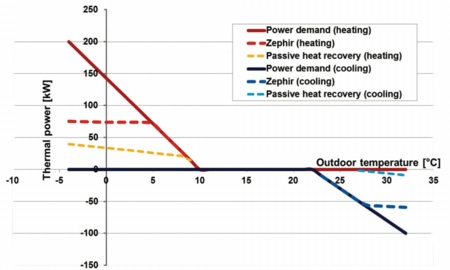Taking MVHR to new levels of performance

Marcus Levy explains how combining heat-pump technology with mechanical ventilation can achieve very efficient heating and cooling performance.
Regulations that require buildings to achieve high levels of airtightness have placed demands on equipment and systems that will deliver fresh air and extract air from the building. How to renew air economically is that challenge that manufacturers of traditional energy-recovery systems face.
Traditional energy-recovery systems, static or rotary, generate pressure drops that typically exceed 250 Pa. The increased fan-power consumption they cause negates a large part of the energy actually recovered.
Clivet has addressed this challenge with its Zephir2 units by combining the need for full fresh air with thermo-dynamic energy-recovery ventilation in a packaged unit that provides filtered fresh air while extracting energy from the exhaust air. The energy recovered is transferred to the conditioned area using heat-pump technology without the high pressure drops associated with cross-flow heat exchangers in traditional systems.
The heating and cooling energy produced reduces the power requirement and cost of additional air-conditioning systems. The system also eliminates the external fresh-air load, providing additional capacity to maintain comfort in the conditioned space.
Heat-recovery coils have a low air resistance, and they are combined with electrostatic H10 filters to ensure very low pressure drops even when the filters are dirty.
There are three stages of capacity control, and heated fresh air can be supplied with a COP of 9.0 and cooled fresh air with an EER reaching 7.1 in standard operating conditions. These capabilities make it possible to reduce primary-plant capacity.
Although efficiency is slightly reduced with an increase in capacity, it still exceeds the efficiency of the primary plant.

The example shown in the graph for a Zephir2 90 unit shows a peak heating load of 200 kW and a peak cooling load of 100 kW. The Zephir2 unit meets all the heating requirement down to 5°C ambient and all the cooling load up to 27°C ambient. That amounts to about 85% of its operating hours. The graph also indicates that the capacity of supporting plant can be reduced.
During the Summer the incoming fresh air is cooled and the extracted heat rejected into the exhaust air stream. The low temperature of the exhaust air stream contributes to efficient operation.
In Winter the cycle is reversed and heat is extracted from the outgoing air stream to and rejected into the fresh air to heat it. The high temperature of the outgoing air helps achieve a high COP.
Zephir2 units can operate in free-cooling mode to bring in purified fresh air using a fan.
Two compressors of different sizes are used to achieve three stages of capacity control.
The range covers air flows from 4500 to 16 000 m3/h. Units can be combined with direct-expansion and VRF air-conditioning systems, chilled beams, existing air-handling units and water-loop heat pumps.







